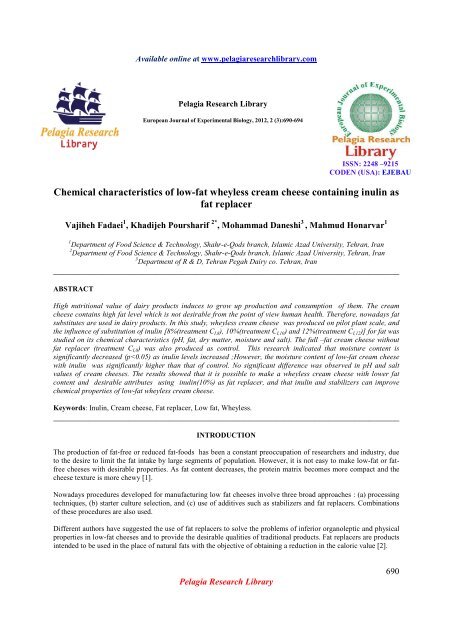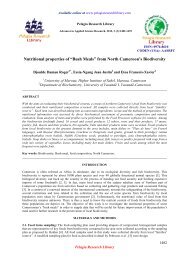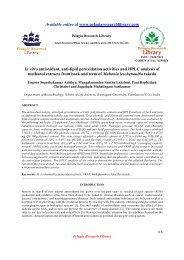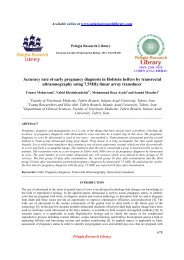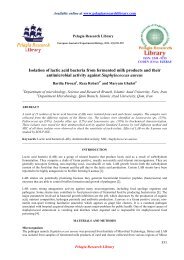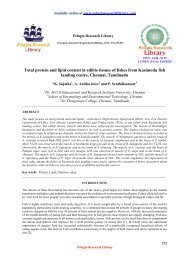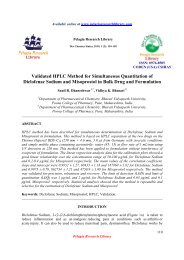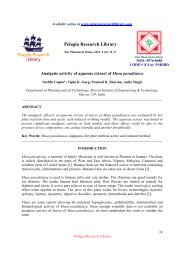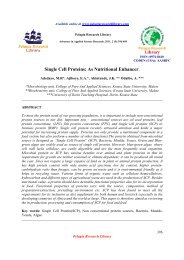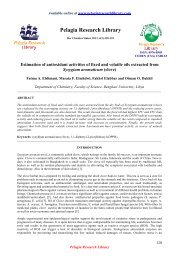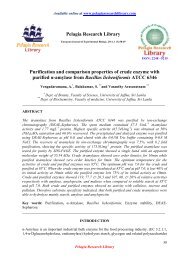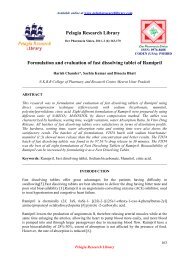Chemical characteristics of low-fat wheyless cream cheese ...
Chemical characteristics of low-fat wheyless cream cheese ...
Chemical characteristics of low-fat wheyless cream cheese ...
You also want an ePaper? Increase the reach of your titles
YUMPU automatically turns print PDFs into web optimized ePapers that Google loves.
Available online at www.pelagiaresearchlibrary.com<br />
Pelagia Research Library<br />
European Journal <strong>of</strong> Experimental Biology, 2012, 2 (3):690-694<br />
ISSN: 2248 –9215<br />
CODEN (USA): EJEBAU<br />
<strong>Chemical</strong> <strong>characteristics</strong> <strong>of</strong> <strong>low</strong>-<strong>fat</strong> <strong>wheyless</strong> <strong>cream</strong> <strong>cheese</strong> containing inulin as<br />
<strong>fat</strong> replacer<br />
Vajiheh Fadaei 1 , Khadijeh Poursharif 2* , Mohammad Daneshi 3 , Mahmud Honarvar 1<br />
1 Department <strong>of</strong> Food Science & Technology, Shahr-e-Qods branch, Islamic Azad University, Tehran, Iran<br />
2 Department <strong>of</strong> Food Science & Technology, Shahr-e-Qods branch, Islamic Azad University, Tehran, Iran<br />
3 Department <strong>of</strong> R & D, Tehran Pegah Dairy co. Tehran, Iran<br />
______________________________________________________________________________<br />
ABSTRACT<br />
High nutritional value <strong>of</strong> dairy products induces to grow up production and consumption <strong>of</strong> them. The <strong>cream</strong><br />
<strong>cheese</strong> contains high <strong>fat</strong> level which is not desirable from the point <strong>of</strong> view human health. Therefore, nowadays <strong>fat</strong><br />
substitutes are used in dairy products. In this study, <strong>wheyless</strong> <strong>cream</strong> <strong>cheese</strong> was produced on pilot plant scale, and<br />
the influence <strong>of</strong> substitution <strong>of</strong> inulin [8%(treatment CI,8), 10%(treatment CI,10) and 12%(treatment CI,12)] for <strong>fat</strong> was<br />
studied on its chemical <strong>characteristics</strong> (pH, <strong>fat</strong>, dry matter, moisture and salt). The full –<strong>fat</strong> <strong>cream</strong> <strong>cheese</strong> without<br />
<strong>fat</strong> replacer (treatment CI,0) was also produced as control. This research indicated that moisture content is<br />
significantly decreased (p
Khadijeh Poursharif et al Euro. J. Exp. Bio., 2012, 2 (3):690-694<br />
______________________________________________________________________________<br />
The terms and definitions used to describe <strong>fat</strong> replacers vary among authors and are <strong>of</strong>ten confusing and<br />
misunderstood. Fat replacers chemically resemble to <strong>fat</strong>s, proteins, or carbohydrates and are generally categorized<br />
into two groups: <strong>fat</strong> substitutes and <strong>fat</strong> mimetics. Fat substitutes are macromolecules that physically and chemically<br />
resemble to triglycerides(conventional <strong>fat</strong>s and oils) and ,<strong>of</strong>ten, referred to as lipid- or <strong>fat</strong>-based <strong>fat</strong> replacers. Fat<br />
substitutes are either chemically synthesized or derived from conventional <strong>fat</strong>s and oils by enzymatic modification.<br />
Fat mimetics are substances that imitate organoleptic or physical properties <strong>of</strong> triglycerides. Fat mimetics, <strong>of</strong>ten<br />
called protein- or carbohydrate- based <strong>fat</strong> replacers, are common food constituents, e.g., starch and cellulose, but<br />
may be chemically or physically modified to mimic the function <strong>of</strong> <strong>fat</strong>. Fat mimetics generally adsorb a substantial<br />
amount <strong>of</strong> water [3].<br />
In recent years, many studies related to <strong>low</strong> <strong>fat</strong> Mozzarella or Cheddar <strong>cheese</strong>s have been published [4-8]. However,<br />
other <strong>cheese</strong>s with higher levels <strong>of</strong> consumption, such as <strong>low</strong> <strong>fat</strong> s<strong>of</strong>t <strong>cheese</strong>s, have received much less attention.<br />
Whey produced from <strong>cheese</strong> making (including <strong>cream</strong> <strong>cheese</strong>), as a by- product, limits productivity. Whey has few<br />
uses and results in the loss <strong>of</strong> valuable proteins for the <strong>cheese</strong> product. The production <strong>of</strong> whey can also create<br />
additional costs for waste treatment, even though whey contains food grade ingredients which have been separated<br />
from milk. The inability <strong>of</strong> whey proteins to be retained in <strong>cheese</strong> is an important factor contributing to a lake <strong>of</strong><br />
efficiency in the production <strong>of</strong> <strong>cheese</strong>, including reduction in overall yield and increased costs [9].Although whey<br />
has sometimes been further processed to obtain food ingredients, the acid whey generated <strong>cream</strong> <strong>cheese</strong> product<br />
cannot normally be utilized in this manner. It would be desirable, therefore, to provide a process for making <strong>cream</strong><br />
<strong>cheese</strong> in which whey is retained in the final product [10].<br />
Wheyless <strong>cream</strong> <strong>cheese</strong> is a s<strong>of</strong>t <strong>cheese</strong> containing more than about 65 percent moisture with a high whey<br />
protein/casein ratio (e.g., about 60/40 or higher) and with desirable firmness which does not involve whey separation<br />
[10].<br />
The most recent definition says that probiotics are live microorganisms administered in amounts that positively<br />
affect the health <strong>of</strong> the host [11, 12].In addition to the probiotic approach <strong>of</strong> directly introducing live bacteria to the<br />
colon through dietary supplementation, another approach to increase the number <strong>of</strong> beneficial bacteria, such as<br />
bifidobacteria, in the intestinal microbiota is through the use <strong>of</strong> prebiotics. Prebiotics are non-digestible dietary<br />
components that pass through to the colon and selectively stimulate the proliferation and/ or activity <strong>of</strong> populations<br />
<strong>of</strong> desirable bacteria in situ [13]. Inulin is a linear β (2 1)-linked fructose polymer that occurs in garlic, asparagus<br />
root, Jerusalem artichoke, dahlia tubers or chicory root [14]. It is a carbohydrate- based <strong>fat</strong> replacer.<br />
Fresh <strong>cream</strong> <strong>cheese</strong> is a <strong>cheese</strong> obtained from the homogenization <strong>of</strong> a fresh <strong>cheese</strong> base with further ingredients,<br />
including gums and hydrocolloids, salt and other spices. This <strong>cheese</strong> is a versatile food that permits addition <strong>of</strong> other<br />
ingredients, including fibres like inulin. It has a spreadable structure, and is used as a spread on bread, in sandwiches<br />
and as a salad dressing. It is an unripened <strong>cheese</strong>, stored at refrigeration temperatures, and the shelf life is rather<br />
limited [15].<br />
The incorporation <strong>of</strong> inulin, as a partial <strong>fat</strong> replacer, specifically in <strong>wheyless</strong> <strong>cream</strong> <strong>cheese</strong>, has not been previously<br />
reported. Therefore, the objective <strong>of</strong> this study was to examine the effect <strong>of</strong> level <strong>of</strong> inulin incorporation on the<br />
chemical properties (pH, <strong>fat</strong>, dry matter, moisture and salt) <strong>of</strong> <strong>wheyless</strong> <strong>cream</strong> <strong>cheese</strong>. For this purpose, the <strong>wheyless</strong><br />
<strong>cream</strong> <strong>cheese</strong> with different contents <strong>of</strong> inulin was produced and investigated.<br />
MATERIALS AND METHODS<br />
2.1 Additives<br />
The fol<strong>low</strong>ing additives are involved in the production <strong>of</strong> <strong>wheyless</strong> <strong>cream</strong> <strong>cheese</strong>:<br />
• Two stabilizers: locust been gum (LBG, Robertet, The Netherlands) and carrageenan (CL220, Danisco,<br />
Denmark).<br />
• Dairy proteins consisted <strong>of</strong> skim milk powder (SMP, Iran), whey protein concentrate (WPC, Progel, Netherlands)<br />
and sodium caseinate (EM7, Netherlands), to provide an aqueous dairy protein blend.<br />
• Inulin (Frutafit TEX, SENSUS, Netherlands) .<br />
• Coagulant (Standard rennet, Chy-Max, Chr, Hansen Inc., Denmark: 183 International MilkClotting Units<br />
(IMCU)/mL (International Dairy Federation, 1997)) .<br />
Pelagia Research Library<br />
691
Khadijeh Poursharif et al Euro. J. Exp. Bio., 2012, 2 (3):690-694<br />
______________________________________________________________________________<br />
2.2 Starter culture<br />
Mesophilic starter culture, contained Lactococcus lactis subsp. Cremoris, Lactococcus lactis subsp. Lactis,<br />
Lactococcus lactis subsp. biovar diacetylactis and Leuconostoc mesenteroides subsp. Cremoris, was obtained from<br />
Chr.Hansen, Denmark.<br />
2.3 Cheese making<br />
Cream <strong>cheese</strong> was made according to the <strong>wheyless</strong> <strong>cream</strong> <strong>cheese</strong> process [10]. Wheyless <strong>cream</strong> <strong>cheese</strong> was<br />
produced from fresh bovine milk. The milk was first standardized t0 the <strong>fat</strong> content <strong>of</strong> about 10-12% for <strong>low</strong> <strong>fat</strong><br />
<strong>cream</strong> <strong>cheese</strong> and 24-28% for high <strong>fat</strong> <strong>cream</strong> <strong>cheese</strong> ,which was kept as control. Then milk was heated at 60 ৹C and<br />
mixed powders skim milk powder(2%w/w), whey protein concentrate(0.5%w/w),locust bean gum (0.01%w/w),<br />
carrageenan,(0.7%w/w),sodium caseinate (5%w/w) and inulin [0%w/w (control or treatment CI,0 ), 8%w/w<br />
(treatment CI,8), 10%w/w (treatment CI,10) and 12%w/w (treatment CI,12). Then was heated at 70 ৹C and homogenized<br />
at about 200 bar and pasteurized at 80 ৹C for 20 min and cooled to 22 ৹C. The pasteurized milk was inoculated with a<br />
mesophilic culture at 22 ৹C and incubated at this temperature until the pH reached a value <strong>of</strong> ~ 4.7. Starter was used<br />
at the rate <strong>of</strong> 1% w/w. After 20 min, rennet was diluted 30 fold with cold water and then added, at concentration <strong>of</strong><br />
4.5 IMCU/kg <strong>of</strong> milk , to milk. The curd was heated, after coagulation, and added salt (0.8w/w). At this point, The<br />
mass was then agitated very gently. The mixture cooked at 40-60 ৹C and homogenized at about 20-70 bar. The<br />
samples were then hot packed at 70 ৹C into 100-g plastic cups and cooled to the storage temperature, 4 ৹C.<br />
2.4 <strong>Chemical</strong> analysis<br />
The <strong>fat</strong> content <strong>of</strong> <strong>cream</strong> <strong>cheese</strong>s was determined by Gerber method [16].The pH <strong>of</strong> <strong>cheese</strong> samples was measured<br />
with a digital pH meter (Mettler Toledo PH meter, model S20-k, Switzerland).Cheese was analyzed for moisture<br />
content by vacuum-oven method [17].Salt content was determined according to the Iran standard methods. All<br />
analyses were conducted after one day <strong>of</strong> storage at 4 ৹C.<br />
2.4 Statistical analysis<br />
Each treatment was performed in three replications. All data are presented as the Mean ± Standard Deviation (SD).<br />
After verifying normality <strong>of</strong> variables, ANOVA analysis fol<strong>low</strong>ed by Duncan post-hoc test for multiple comparisons<br />
were done at significant level <strong>of</strong> 0.05 (p
Khadijeh Poursharif et al Euro. J. Exp. Bio., 2012, 2 (3):690-694<br />
______________________________________________________________________________<br />
a Means within the same row with different superscript letters differ significantly (P 0.05). This result<br />
agree with that reported by Katsiari et al. [19].The moisture content <strong>of</strong> <strong>low</strong> <strong>fat</strong> <strong>cheese</strong>s made with inulin were<br />
significantly higher than full <strong>fat</strong> <strong>cheese</strong> made by a similar technology(p
Khadijeh Poursharif et al Euro. J. Exp. Bio., 2012, 2 (3):690-694<br />
______________________________________________________________________________<br />
[11]FAO/WHO, Evaluation <strong>of</strong> health and nutritional properties <strong>of</strong> probiotics in food including powder milk with<br />
live lactic acid bacteria: Report <strong>of</strong> a Joint FAO/WHO Expert Consultation.2001,<br />
ftp://ftp.fao.org/es/esn/food/probioreport_en.pdf, Co´rdoba, Argentina.<br />
[12]Sanders M E, Nutrition Reviews, 2003, 61(3), 91–99.<br />
[13]Mattila-Sandholm T, Mylla¨rinen P, Crittenden R, Mogensen G, Fonde´n R, Saarela M,International Dairy<br />
Journal,2002, 12, 173–182.<br />
[14]Rocha J R, Catana R, Ferreira B S,Cabral J M S, Fernandes P, Food Chemistry,2006, 95, 77–82.<br />
[15]Heller K J, Bockelmann W, Schrezenmeir J, deVrese M, Cheese and its potential as a probiotic food. In E R<br />
Farnworth (Ed.), Handbook <strong>of</strong> fermented functional foods, Boca Raton: CRC,2003,203-225.<br />
[16]James C S, Analytical chemistry <strong>of</strong> foods (1st ed.), 1995, Glasgow, UK: Blackie Academic & Pr<strong>of</strong>essional.<br />
[17]AOAC, Association <strong>of</strong> <strong>of</strong>ficial Analytical chemists, Official Methods <strong>of</strong> Analysis (16th ed). Arlington, VA,<br />
USA: AOAC,1997, method 926. 08 (3rd rev.).<br />
[18]Lisazoian,L,Joarusti L, SPSS for windows, version 6.0,1995, Buenos Aires: Editorial Paraninfo.<br />
[19]Katsiari M C, Voutsinas L P, Kondyli E, International Dairy Journal,2002, 12, 757–764.<br />
[20]Zalazar C A, Zalazar C S, Bernal S, Bertola N, Bevilacque A, Zaritzky N, International Dairy Journal,<br />
2002, 12, 45–50.<br />
[21]Fenelon M A., O’Connor P, Guinee T P, Journal <strong>of</strong> Dairy Science,2000, 83, 2173–2183.<br />
[22]McMahon D J, Alleyne M C, Fife R L, Oberg C J, Journal <strong>of</strong> Dairy Science, 1996,79, 1911–1921.<br />
[23]Rahimi J, Khosrowshahi A, Madadlou A, Aziznia S, Journal <strong>of</strong> Dairy Science,2007, 90,4058-4070.<br />
[24]Taghvaie Z, Taslimi A., Mazloumi M T, IJFST, 2006,1,1-11.<br />
[25]Lashgari H, khosrowshahi A, yourghanlou ashrafi R, zohri M, IJFST, 2008,3,1-10.<br />
[26]Buriti F, Cardarelli H, Filisetti T, Saad S, Food Chemistry,2007, 104, 1605–1610.<br />
Pelagia Research Library<br />
694


